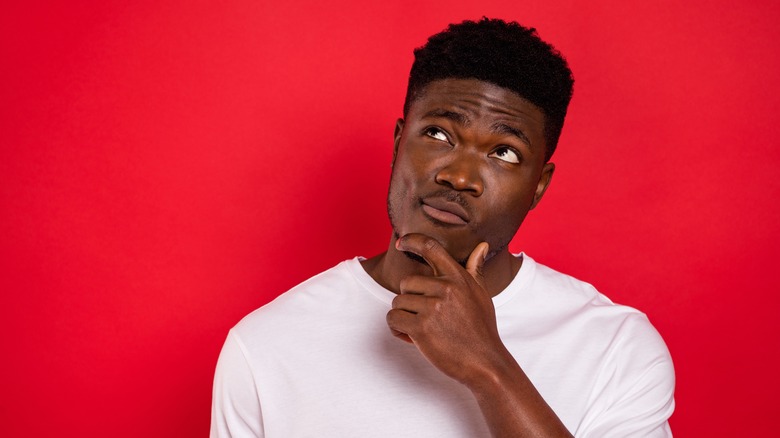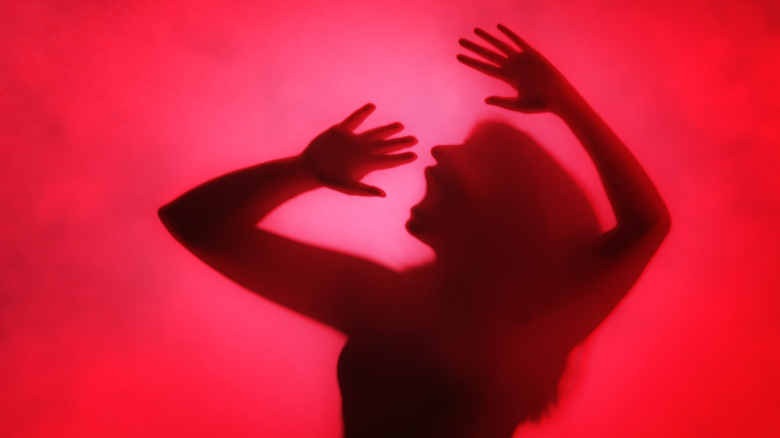8 Strange Ways The Color Red Might Affect Your Brain
Color can evoke a wide spectrum of emotions and responses in humans. It's likely that you developed a favorite color as a child, and have since added other colors to a list of others you prefer as well as ones you'd rather avoid. There's more to responses to colors than personal preferences, culture, and personality traits, though. Some researchers believe that intense responses to color have to do with a psychological concept known as color theory. Color theory contends that certain colors are associated with specific psychological and emotional responses. As patterns have emerged among larger numbers of people, it's easy to fall into the trap of making generalizations based on color and responses.
Red is perhaps one of the most widely acknowledged colors within scientific studies. It's arguably the most complex, too. What makes red unique within color theory is its association with both positive and negative effects on the brain. Seeing red might cause either one of these outcomes depending on the situation. At the same time, there's limitations to color theory's approach to the color red, as not every single individual will experience the same responses when they encounter it. While there are certainly some caveats when it comes to color theory, there's a decent amount that current research has to say about the color red and how it can possibly affect your brain.
Red may illicit angry emotions
Red is a warm and highly emotional color. In this regard, you might associate red with anger, a fiery emotion that evokes some of the same colors as a fire. Perhaps you even remember old cartoons where characters literally turned red in anger. Color theory posits that there's more to this association between anger and the color red, though. Not only might we literally feel fired up when angry, but seeing the color might affect our brains in a way that makes us more prone to anger overall. A 2012 study published in the journal Cognition & Emotion even found that people were more likely to feel anger when confronted with the color red as compared to their reactions to anger-related language.
The red-anger link also persists in human culture in other ways. For example, while now an established myth, there's an association between the color red and a bull's anger. If you've ever seen a person holding a red cape in a bull fight, chances are you've also seen a bull charge towards the fabric. It's not the color of the cape that bulls get so angry about, though. In fact, bulls cannot see the color at all. Nevertheless, this still remains an enduring example of how humans associate the color red with anger, though.
Red might make you feel energetic
Psychology also suggests that certain colors might impact energy levels. Whether you're exposed to colors on walls inside a building or those within the clothing you wear, you might find that some hues might indeed affect whether you're energetic or more stagnant. Due to its warmth as well as its fiery nature, red is unsurprisingly among the more energetic colors you'll encounter. In fact, research dating back to the 1960s deemed red to be a more "arousing" color from a behavioral standpoint when compared with cool colors. Such effects also stand in direct contrast with blue, which is often associated with more calmness.
More recently though, researchers have determined that the potential energizing effects of the color red on the brain often depend on the context, as was discussed in a 2016 study published in PeerJ. This might just explain why red might make you feel more energetic in a positive way, but can also be connected with negative impacts such as stress, anxiety, and burnout. Furthermore, a 2015 study published in the journal Color Research and Application discovered that college students who were exposed to the color red experienced an increased heart rate when compared with muted colors. (While this particular study assessed color and emotional responses, there are ways your heart rate can predict your future health, too.) Overall, the research does reveal that red can be energizing, but more studies may be needed to determine any potential long-term positive versus negative impacts.
Wearing red is thought to improve athletic performance
Next time you go to a sporting event, pay close attention to what some of the athletes wear. Unless they are part of a team with mandatory uniforms, you might notice a theme in color choices among these athletes. Red is particularly ubiquitous, and it's among the more popular color an athlete may choose to wear. This is a hardly a coincidence, though. Aside from possible increased energy, wearing red is often associated with improved athletic performance. In turn, an athlete might choose to intentionally wear red attire before a big game for good luck.
It's this subconscious aspect that has piqued the interest of scientists studying color theory. Research even suggests that people who wore red during sports competitions had a higher likelihood of winning. Just know that red isn't likely to really make someone "naturally athletic," though. If an athlete does well during consecutive events while wearing red, chances are this is more of an effect on their psychological state, or perhaps a mere coincidence — not necessarily a proper physical change. Nevertheless, some organizations are starting to limit the use of red attire during competitions in order to prevent possible unfair advantages.
Imminent danger may be associated with the color red
Certain parts of the human brain control decision making, but color perceptions can also play a role. Such is the case when you might encounter the color red in a more dangerous situation. One notable example in western societies is the use of the color red for danger and warning signs or signals. This isn't a coincidence, but rather an intentional one made to work with the human brain so that people can quickly take action to protect themselves.
There's a few theories as to why the human brain might associate danger with the color red. While some might argue that red paint is intentionally used to help people see danger and warning cues better from far away, others believe something else might be at play here. In fact, it's possible that the human brain might make connections between red and other dangerous entities within the same color range, such as blood or fire. Interestingly, some other animals have been known to associate the color red with danger, too, and some primate species will associate red facial markings with social dominance.
You might connect red with power and status
Just as the brain might associate red with dangerous situations, you might even associate the color with power or overall relevance. Both cases point to the brain's perception of red as an important color that warrants attention, but the color may even have a dominating effect on the brain. For example, a 2017 study published in Frontiers in Psychology noted the links between the color red and power after participants were asked to categorize different colored words as related to rest or dominance. In this case, the study participants overwhelmingly linked red with dominance. On the other hand, blue words were linked with rest (gray was selected as the control case).
Similarly, you might notice that people in positions of power or those aspiring to be included in a higher social status might wear red. Research has long-established the use of the color red to indicate power and status, as well as wealth. For example, you may have seen politicians or monarchs wear some red clothing in an attempt to appear more powerful or dominating over others. The same goes with businesspeople or celebrities who might opt for red dresses, ties, and bags, as well as the fashion-conscious among us who might regard red as a spicy summer color to wear. The color red's powerful associations don't stop at attire, though. You might see the color adorning furniture, vehicles, and decorations among those who long to look like they are of a higher status. Overall, these power-seeking individuals may want to use the color red to appear dominating, and it may just work in some cases.
The color red might make you confident
Aside from power and status, the color red might also be associated with something a bit more innocuous: confidence. For example, people who wear red might feel confident from the get-go. On the flipside, people who observe others wearing red might perceive these red attire-wearers as more confident individuals, too. Research has even suggested that the color red can affect perceived competitive advantage. As one study from the Journal of Sport and Exercise Psychology found, competitors were more likely to regard themselves as confident and dominant while wearing red, but these athletes were also found to perceive the same qualities in others who wore red, too.
The link between red and confidence may have something to do with the boldness of the color. If one is courageous enough to wear red clothing, for example, then you might assume they're confident go-getters. Some even argue that wearing red lipstick is always a good idea when you're trying to be bold and confident. There's also some debate about whether it's the actual color that signals confidence to the brain among observers, or whether the person wearing the color red exudes the confidence that people see. One possible theory is that people historically associated rosy-looking skin with good health and well-being, and therefore might regard red clothing wearers in a more positive light, too.
Red is also associated with love and passion
While red is a fiery color that can evoke danger, energy, and confidence, it's also a passionate color. In particular, red has historically been associated with love. It's arguably the quintessential color associated with Valentine's Day, as well as romance more generally. As a child, you may have drawn hearts from time to time, and were perhaps most likely to color them red over any other crayon in your box.
Beyond the cultural associations between red and love, though, research has shown that the color may evoke feelings of love in our brains, too. One notable 2008 study in the Journal of Personality and Social Psychology reported that the color particularly evoked passion on the part of males. When shown photos of women framed with different colors, male participants rated those framed with red as more attractive; interestingly, the color did not have the same impacts on female study participants. While future research is needed to confirm the effects of red on the brain in terms of romantic love, this study was considered the first of its kind to look at the science between these connections. Since then, other studies have attempted to explore other psychological facets of red in terms of love and passion. More recently, for example, a 2023 study published in PLoS One attempted to explore the color red's effects on perceptions of female fertility. However, the researchers found mixed results.
Red may even stimulate your appetite
A final major effect red might have on your brain is a stimulating one. Aside from passion or energy, this particular color might have some sway over your appetite for food. Seeing red foods or — other colored foods that are placed in red packaging — is thought to increase feelings of hunger. Also, when you're already hungry and are looking for a meal or snack, you might be more inclined to choose those in red packages.
Such effects of the color red on the brain are being used by food companies to their advantage. Take a look next time you go to the grocery store, and pay close attention to how many food manufacturers use red in their boxes or can labels. You might even notice a lot of red used in food ads, as well as in fast food restaurant logos and packaging. Interestingly, while this red scheme might work on some people, the effects aren't always so clear-cut. For example, 2021 research found that red on food packaging might actually cause negative feelings and behaviors, such as guilt. Needless to say, this connection between the color red and appetite stimulation warrants further study.








